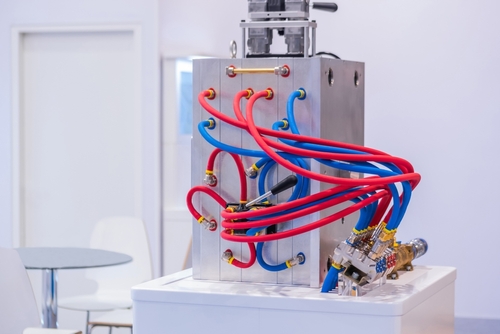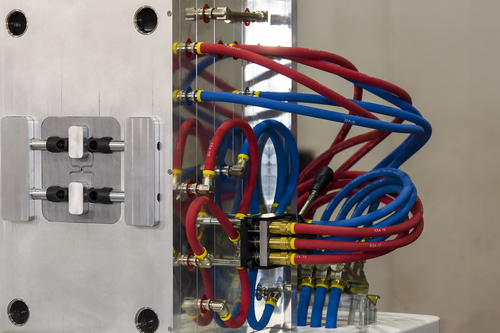Cooling time in injection molding refers to the time between the point when the molten material fills the cavity and when the mold can be opened and the product ejected. The duration of this period depends on several factors, including wall thickness, the temperature of the molten plastic, and the mold temperature. Experts at injection mold manufacturing companies use a specific formula to determine the cooling time for each project. Keep reading to learn more about why cooling time is an essential part of the process.
What is the effect of cooling time in injection molding?
 The injection molding cycle consists of several phases, including mold closing, filling, holding, cooling, and demolding. Among these steps, cooling time takes up the largest portion of time, about 70% to 80% and has a direct impact on the quality of the final product.
The injection molding cycle consists of several phases, including mold closing, filling, holding, cooling, and demolding. Among these steps, cooling time takes up the largest portion of time, about 70% to 80% and has a direct impact on the quality of the final product.
When the cooling process isn’t executed properly, the material won’t harden enough, which can result in damage from the ejector pins. Mold design can also affect the cooldown process and cause increased shrinkage, warping, discoloration, delamination, and sinking.
For example, when it comes to intricate patterns, mold designers can implement cooling channels into the mold design to lower the temperature of the cavity wall and help disperse heat evenly, resulting in uniform cooling.
However, too much cooling can lead to unnecessarily long cycle times. That’s why it’s essential for experts to accurately estimate the optimal duration of this stage.
How to calculate the cooling time?
By using an equation that takes into account wall thickness and thermal diffusivity, which quantifies the plastic’s density, thermal conductivity, and energy requirements, engineers can calculate the optimal cooling time. It also depends on the type of resin, as different thermoplastics have different molding and melting temperatures.
What will happen if cooling time is less?
When the cooling time is too short, it can lead to several defects and quality issues in the final part, compromising both its appearance and functionality. Here are some common problems that can be caused by insufficient cooldown time:
- Warping or distortion: The part could bend or twist as it continues to cool unevenly after being ejected from the mold.
- Sink marks: Thicker areas may not solidify properly, leading to sunken spots on the surface.
- Incomplete part formation: The plastic may not fully fill the mold cavity or lose shape before setting.
- Poor dimensional accuracy: Parts could shrink unpredictably after removal, affecting fit and function.
- Surface defects: The part can have a rough finish or show signs of deformation.
- Increased scrap rate: More parts could be rejected due to quality issues, increasing waste and cost.
- Cracking under stress: Internal stress can build up, especially near ribs or corners, leading to cracks during use or assembly.
- Failure in pressure-bearing parts: Parts designed to handle mechanical loads may fail prematurely because of incomplete material bonding.
For consistent quality, it’s crucial to allow the material enough time to cool and solidify before ejection.
 What are reliable injection mold manufacturing companies?
What are reliable injection mold manufacturing companies?
If you’re wondering what makes injection molding one of the most efficient manufacturing processes, what additives and colorants can be used in the process, or how wall thickness can affect the molded parts, our experienced team at Wunder Mold is here to address any questions or concerns you may have. With years of experience in the industry and a crew of knowledgeable, skilled, and dedicated specialists, we work closely with our clients to understand your needs and deliver high-quality parts that are in line with the specific requirements of each application. Whether you’re located in the U.S. or worldwide, give us a call or send an email at sales@wundermold.com and tell us more about how we can help.
 What are reliable injection mold manufacturing companies?
What are reliable injection mold manufacturing companies?